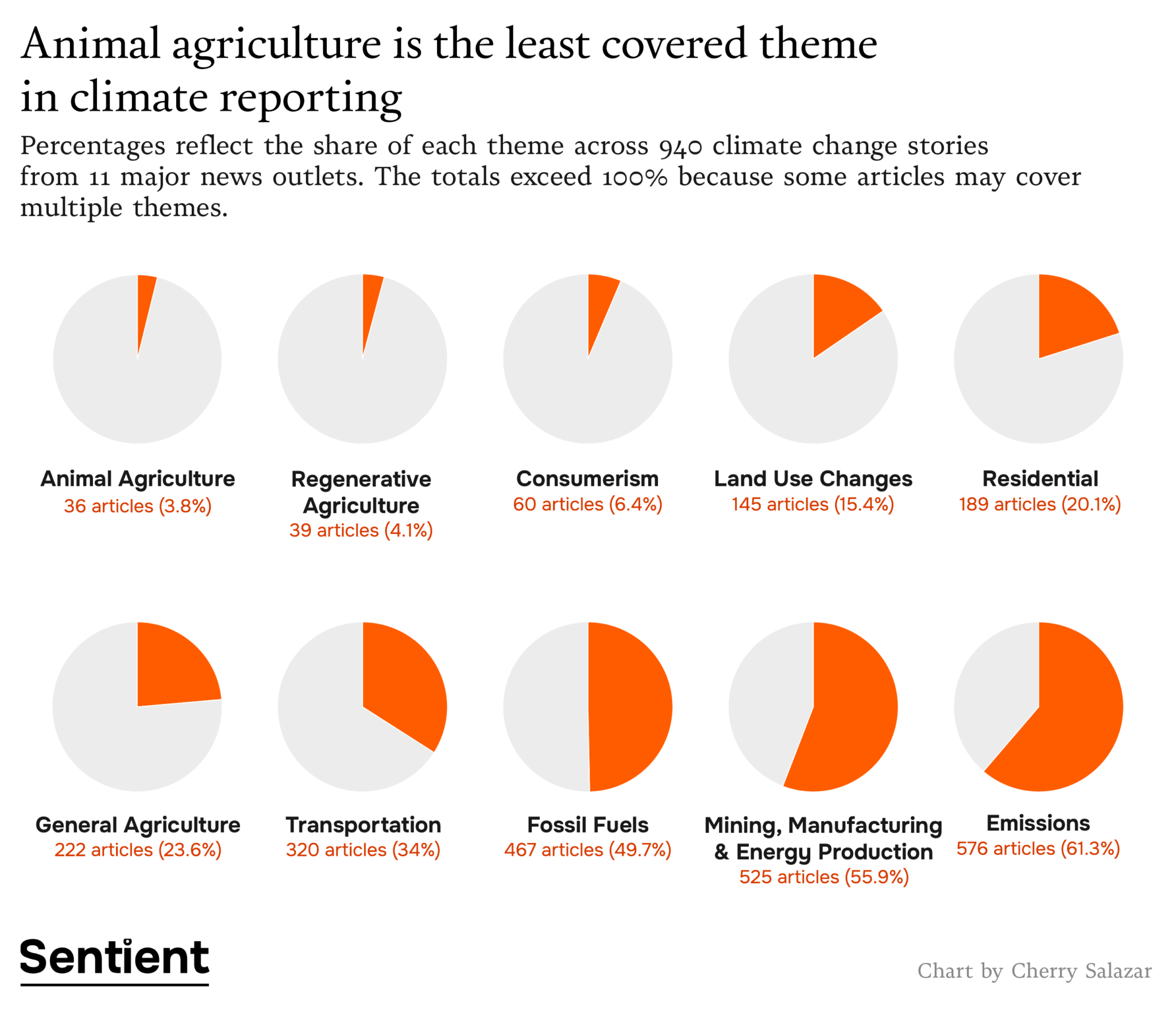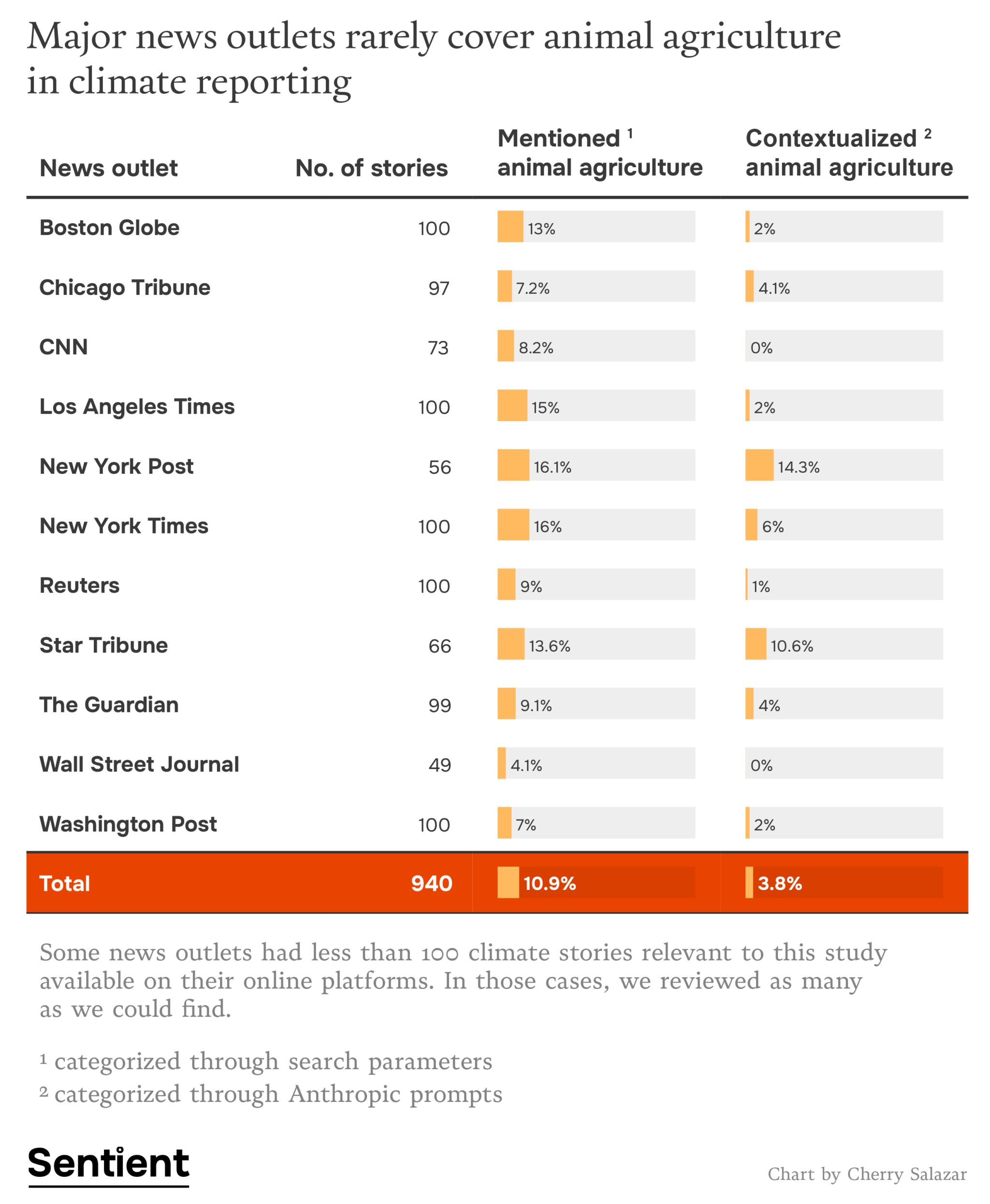Explainer
How Overconsumption Affects the Environment and Health, Explained
Climate•12 min read
Analysis
An opportunity for climate journalists to expand their coverage by including the largest source of food-related emissions.


Words by Cherry Salazar
Background. Roughly a third of all greenhouse gas emissions are driven by food systems, and meat, especially beef, is the largest driver of those food-related emissions. Yet a 2023 Washington Post/University of Maryland poll found 74 percent of U.S. respondents thought eating less meat would have little to no effect on climate change.
Sentient Media set out to analyze how often climate news reports animal agriculture as a cause of climate change. Sentient analyzed 940 of the most recent climate news stories across 11 news outlets. Out of the stories studied, 96.2 percent made no mention of meat or livestock production as a cause of climate change.
Article Selection. Sentient team members downloaded copies of the most recent climate news stories available on each site, reviewing and omitting stories that were opinion pieces or a mention of climate change in passing (say, for instance, a story about a podcast that touches on climate change).
The news outlets, primarily U.S.-based, are as follows:
Washington Post: 100 articles
Reuters: 100 articles
The Boston Globe: 100 articles
NY Times: 100 articles
CNN: 73 articles*
WSJ: 49 articles*
New York Post 56 articles*
Los Angeles Times 100 articles
Star Tribune: 66 articles
Chicago Tribune: 97 articles
The Guardian: 99 articles
Total: 940 articles
(*) number of maximum relevant articles available
A number of outlets had minimal coverage of climate change relevant to the study (e.g., not a minor mention) available on their online platforms. In those cases, we reviewed less than 100 articles, but as many as we could find.
Methods. Sentient Media ran two computational methods: one categorized articles using the same search parameters used in a 2023 study published by Sentient and data researchers Faunalytics, while the other analyzed them using Anthropic Claude API, with each category defined by detailed classification criteria. (Search parameters for stories tagged animal agriculture included, among others, “meat”, “dairy”, “livestock”, “chicken farm”,“cattle shelter”, “seafood”, and “fisheries”.)

Findings. Using the Anthropic method, the analysis showed 96.2 stories did not mention animal-based farming as a cause of greenhouse gas emissions. This means only 36 out of 940 climate stories had both mentioned and contextualized the climate impacts of animal agriculture.

Of the 11 news outlets, the New York Post had the biggest share of contextualized meat- and food-related climate stories, with 14 percent or eight out of its 56 stories studied. The New York Times, Boston Globe and Los Angeles Times mentioned animal agriculture in at least 15 percent of their respective climate reporting but very few addressed climate impacts.
Using the same parameters as the 2023 study on a more carefully selected set of articles, we found only 10.9 percent mentioned animal agriculture. More details on the limitations follow.
The 2023 study found that 93 percent of climate news stories failed to mention meat and livestock farming as a cause of climate change. One way this year’s study differs, in addition to incorporating analysis involving a large language model, is that Sentient culled more irrelevant articles from the total. That was a limitation of the earlier study, which was noted in the report, in which Faunalytics and Sentient researchers noted that the 93 percent figure was lower than what would likely be the true figure.
The search parameters used for the 2023 analysis was a blunter way of searching, as we noted in the study then, as the results included all stories with any mention of livestock farming, not necessarily just those that noted in the reporting that livestock farming, particularly cattle ranching, is a source of greenhouse gas emissions. Some stories, for instance, reported on ranchers and other livestock farmers experiencing the impacts of climate change like extreme heat, without mentioning livestock farming as a source.
The use of artificial intelligence tools, including training large language models, is characterized by intensive energy and water consumption. However, AI-related emissions, while increasing, are still minor compared to that of global livestock production, which is responsible for at least 12 percent of emissions. Similarly, while ChatGPT and Google’s Bard use 18.2–18.9 billion liters of water, animal farming and by-products require over 5 trillion liters of water.
For this search in particular, each time running the analysis used approximately 3,000 watt hours. This is about the same as 1 load of laundry (washer and dryer). Anthropic in particular doesn’t release exact numbers on their electricity usage, however, as other large AI models have, so this is a very rough estimate.
Limitations. Though we manually reviewed the articles for inclusion, we may still have included some that aren’t appropriate for the analysis. We only looked at a limited number of articles due to cost and time limitations.
In addition, this analysis is not meant to suggest that fossil fuels and other drivers of climate change should have less media attention or that all stories included in the search must mention animal agriculture. The point is to illuminate opportunities for reporting, and illuminate the lack of coverage on animal agriculture’s role in climate journalism.